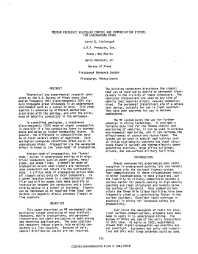Mining Publication: Medium Frequency Vehicular Control and Communications Systems for Underground Mines
Original creation date: January 1984
Theoretical and experimental research sponsored by the U.S. Bureau of Mines shows that medium frequency (MF) electromagnetic (EM) signals propagate great distances in an underground environment such as a tunnel or mine. This propagation is enhanced by different mechanisms associated with the geology, and with the existence of metallic conductors in the entryways. In stratified geologies, a transverse electromagnetic (TEM) mode of signal propagation is possible if a low conducting layer is bounded above and below by higher conducting layers. In general, the difference in conductivities must be at least several orders of magnitude. Such geological waveguide conditions often exist in underground mines. Propagation via the waveguide effect is known as the "seam mode" of propagation. Another mode of propagation, the "tunnel mode," exists in underground entries with electrical conductors such as power cables, metal pipes, and phone lines. A monofilar mode of propagation exists when signals are impressed upon conductors and return via the surrounding rock. A bifilar mode of propagation exists when all signals exist only on local conductors. In a given location there is a combination of monofilar and bifilar modes that make possible an interaction between the conductors and a transmitting device in a tunnel or entryway. Signals can be impressed on or received from local conductors via magnetic dipole antennas (loops) or line couplers.
Authors: LG Stolarczyk, HH Dobroski
Conference Paper - January 1984
34th IEEE Vehicular Technology Conference, Vol 34; 1984 May; :316-321
See Also
- Performance and Safety Investigation of Emergency Backup Batteries and Battery Charging Systems for Underground Mining Applications
- Practical Risk Assessment Guidelines for Identifying, Assessing, and Mitigating Stored Energy Hazards in Underground Coal Mines During and After a Mine Emergency
- Propagation of EM Signals in Underground Mines
- Radio System Modifications for Improved Mine Safety (Medium Frequency)
- Refuge Alternatives in Underground Coal Mines
- Safe and Economical Inerting of Sealed Mine Areas
- Subterranean Wireless Electronic Communication System
- Technology News 546 - Medium Frequency Mine Emergency Communications—An Emerging Technology
- Ultra-Low Frequency Through-the-Earth Communication Technology
- Wireless Mesh Mine Communication System
- Page last reviewed: 9/21/2012
- Page last updated: 9/21/2012
- Content source: National Institute for Occupational Safety and Health, Mining Program


 ShareCompartir
ShareCompartir
